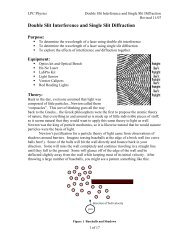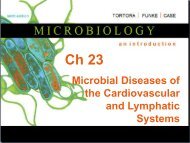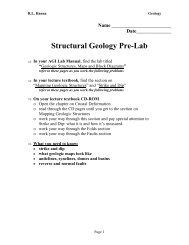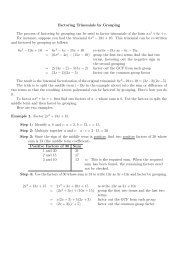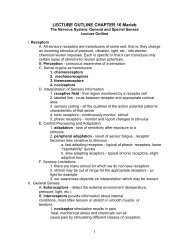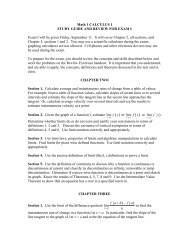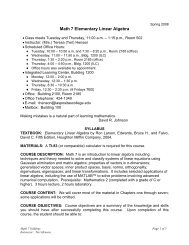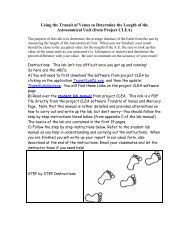Chapter 7 The Control of Microbial Growth
Chapter 7 The Control of Microbial Growth
Chapter 7 The Control of Microbial Growth
You also want an ePaper? Increase the reach of your titles
YUMPU automatically turns print PDFs into web optimized ePapers that Google loves.
<strong>Chapter</strong> 7<br />
<strong>The</strong> <strong>Control</strong><br />
<strong>of</strong> <strong>Microbial</strong><br />
<strong>Growth</strong>
SLOs<br />
• Define sterilization, disinfection, antisepsis, sanitization, biocide, germicide,<br />
bacteriostasis, and asepsis.<br />
• Describe the microbial death curve.<br />
• Describe the effects <strong>of</strong> microbial control agents on cellular structures.<br />
• Compare effectiveness <strong>of</strong> moist heat (autoclaving, pasteurization) vs .dry<br />
heat.<br />
• Describe how filtration, low temperature, high pressure, desiccation, and<br />
osmotic pressure suppress microbial growth.<br />
• Explain how radiation kills cells.<br />
• List the factors related to effective disinfection.<br />
• Interpret results <strong>of</strong> use-dilution tests and the disk-diffusion method.<br />
• Identify some methods <strong>of</strong> action and preferred uses <strong>of</strong> chemical disinfectant<br />
• Differentiate between halogens used as antiseptics and as disinfectants.<br />
• Identify the appropriate uses for surface-active agents.<br />
• List the advantages <strong>of</strong> glutaraldehyde over other chemical disinfectants.<br />
• Identify the method <strong>of</strong> sterilizing plastic labware.<br />
• Explain how microbial control is affected by the type <strong>of</strong> microbe.<br />
Copyright © 2010 Pearson Education, Inc.
Terminology<br />
• Sepsis: microbial<br />
contamination.<br />
• Asepsis: absence <strong>of</strong> significant contamination.<br />
• Aseptic surgery techniques prevent microbial<br />
contamination <strong>of</strong> wounds.<br />
• Antimicrobial chemicals, expected to destroy<br />
pathogens but not to achieve sterilization<br />
• Disinfectant: used on objects<br />
• Antiseptic: used on living tissue<br />
• Nosocomial<br />
Copyright © 2010 Pearson Education, Inc.
Copyright © 2010 Pearson Education, Inc.<br />
. . . More Terminology<br />
• Sterilization: Removal <strong>of</strong> all<br />
microbial life (heat, filtration)<br />
• For food: Commercial sterilization to kill<br />
C. botulinum endospores<br />
• Sanitization: reduces microbial numbers to safe<br />
levels (e.g.: eating utensils)<br />
• Bacteriostatic: Inhibits bacterial<br />
reproduction<br />
• Bactericidal: Kills bacteria<br />
• Fungicide, sporicide, germicide,<br />
biocide
Rate <strong>of</strong> <strong>Microbial</strong> Death<br />
Bacterial populations subjected to heat or<br />
antimicrobial chemicals die at a constant rate.<br />
<strong>Microbial</strong> Death<br />
Curve, plotted<br />
logarithmically,<br />
shows this<br />
constant death<br />
rate as a straight<br />
line.<br />
Rate: 90% / min<br />
Copyright © 2010 Pearson Education, Inc.<br />
Fig 7.1<br />
Figure 7.1a
• How is it possible that a solution containing a million<br />
bacteria would take longer to sterilize than one<br />
containing a half-million bacteria? 7-2<br />
Copyright © 2010 Pearson Education, Inc.
Effectiveness <strong>of</strong> Antimicrobial Treatment<br />
Depends on<br />
• Time it takes to kill a microbial population is<br />
proportional to number <strong>of</strong> microbes.<br />
• <strong>Microbial</strong> species and life cycle phases (e.g.:<br />
endospores) have different susceptibilities to<br />
physical and chemical controls.<br />
• Organic matter may interfere with heat treatments<br />
and chemical control agents.<br />
• Exposure time: Longer exposure to lower heat<br />
produces same effect as shorter time at higher<br />
heat.<br />
Copyright © 2010 Pearson Education, Inc.
Actions <strong>of</strong> <strong>Microbial</strong> <strong>Control</strong> Agents<br />
• Alternation <strong>of</strong> membrane permeability<br />
• Damage to proteins<br />
• Damage to nucleic acids<br />
Copyright © 2010 Pearson Education, Inc.
Physical Methods <strong>of</strong> <strong>Microbial</strong> <strong>Control</strong><br />
• Heat is very effective (fast and cheap).<br />
• <strong>The</strong>rmal death point (TDP): Lowest temperature at<br />
which all cells in a culture are killed in 10 min.<br />
• <strong>The</strong>rmal death time (TDT): Time to kill all cells in a<br />
culture<br />
• Decimal Reduction Time (DRT):<br />
Minutes to kill 90%<br />
<strong>of</strong> a population at a<br />
given temperature<br />
Copyright © 2010 Pearson Education, Inc.<br />
Table 7.2
• Denatures proteins<br />
Copyright © 2010 Pearson Education, Inc.<br />
Moist Heat Sterilization<br />
• Autoclave: Steam under pressure<br />
• Most dependable sterilization method<br />
• Steam must directly contact material to be sterilized.<br />
• Pressurized steam reaches<br />
higher temperatures.<br />
• Normal autoclave conditions:<br />
121.5C for 15 min.<br />
• Prion destruction:<br />
132C for 4.5 hours<br />
• Limitations <strong>of</strong> the autoclave
Pasteurization<br />
• Significant number reduction (esp. spoilage and<br />
pathogenic organisms) does not sterilize!<br />
• Historical goal: destruction <strong>of</strong> M. tuberculosis<br />
• Classic holding method: 63C for 30 min<br />
• Flash pasteurization (HTST): 72C for 15 sec.<br />
Most common in US.<br />
<strong>The</strong>rmoduric organisms survive<br />
• Ultra High Temperature (UHT):<br />
140C for < 1 sec.<br />
Technically not pasteurization because it<br />
sterilizes.<br />
Copyright © 2010 Pearson Education, Inc.
Dry heat sterilization kills by oxidation<br />
• Flaming <strong>of</strong> loop<br />
• Incineration <strong>of</strong> carcasses<br />
Anthrax<br />
Foot and mouth disease<br />
Bird flu<br />
• Hot-air sterilization<br />
Equivalent<br />
treatments<br />
Hot-air<br />
170˚C, 2 hr<br />
Autoclave<br />
121˚C, 15<br />
min<br />
Copyright © 2010 Pearson Education, Inc.
Filtration<br />
• Air filtration using high efficiency particulate<br />
air (HEPA) filters. Effective to 0.3 m<br />
• Membrane filters for fluids.<br />
• Pore size for bacteria: 0.2 – 0.4 m<br />
• Pore size for viruses: 0.01 m<br />
Fig 7.4<br />
Copyright © 2010 Pearson Education, Inc.
Low Temperature<br />
• Slows enzymatic reactions inhibits microbial growth<br />
• Freezing forms ice crystals that damage microbial cells<br />
• Refrigeration (watch out for _________________!, deep<br />
freezing, lyophilization<br />
Various Other Methods<br />
◦ High pressure in liquids denatures bacterial proteins<br />
and preserves flavor<br />
◦ Desiccation prevents metabolism<br />
◦ Osmotic pressure causes plasmolysis<br />
Copyright © 2010 Pearson Education, Inc.
Ionizing Radiation<br />
• X-rays, -rays, electron beams <br />
dislodge e- from atoms production<br />
<strong>of</strong> free radicals and other highly reactive<br />
molecules<br />
• Commonly used Cobalt-60 radioisotope<br />
• Salmonella and Pseudomonas are particularly<br />
sensitive<br />
• Sterilization <strong>of</strong> heat sensitive materials: drugs,<br />
vitamins, herbs, suture material<br />
• Also used as ―cold pasteurization‖ <strong>of</strong> food <br />
Consumer fears!?<br />
Copyright © 2010 Pearson Education, Inc.
Nonionizing Radiation: UV light<br />
• Most effective wave legnth<br />
~ 260 nm<br />
• Effect: thymine dimers<br />
• Actively dividing organisms are more sensitive<br />
because thymine dimers cause . . . .?<br />
• Used to limit air and surface contamination. Use at<br />
close range to directly exposed microorganisms<br />
• E.g.: germicidal lamps in OR, cafeteria, and our lab ??<br />
Copyright © 2010 Pearson Education, Inc.
Nonionizing Radiation: Microwave<br />
• Wavelength: 1 mm – 1m<br />
• H 2 O quickly absorbs energy<br />
release as heat to environment<br />
• Indirect killing <strong>of</strong> bacteria through heat<br />
• Solid food heats unevenly, why?<br />
<br />
Fig 7.5<br />
Copyright © 2010 Pearson Education, Inc.
Chemical Methods <strong>of</strong> <strong>Microbial</strong> <strong>Control</strong><br />
• Few chemical agents achieve sterility.<br />
• Consider presence <strong>of</strong> organic matter, degree <strong>of</strong> contact<br />
with microorganisms, and temperature<br />
• Disinfectants regulated by EPA<br />
Antiseptics regulated by FDA<br />
• Use-dilution test<br />
1. Metal rings dipped in test bacteria are dried.<br />
2. Dried cultures <strong>of</strong> S. choleraesuis, S. aureus, and P.<br />
aeruginosa are placed in disinfectant for 10 min at<br />
20C.<br />
3. Rings are transferred to culture media to determine<br />
whether bacteria survived treatment.<br />
Copyright © 2010 Pearson Education, Inc.
Disk-diffusion Method<br />
Disk <strong>of</strong> filter paper is soaked with a chemical and<br />
placed on an inoculated agar plate; a zone <strong>of</strong><br />
inhibition indicates effectiveness.<br />
Fig 7.6<br />
Copyright © 2010 Pearson Education, Inc.
Types <strong>of</strong> Disinfectants<br />
• Phenol = carbolic acid<br />
(historic importance)<br />
• Phenolics: Cresols (Lysol)<br />
- disinfectant<br />
• Bisphenols<br />
• Hexachlorophene<br />
(pHisoHex, prescription),<br />
hospitals, surgeries,<br />
nurseries<br />
• Triclosan (toothpaste,<br />
antibacerial soaps, etc.)<br />
Fig 7.7<br />
Phenol and derivatives disrupt plasma membranes<br />
(lipids!) and lipid rich cell walls (??)<br />
Remain active in presence <strong>of</strong> organic compoundsP<br />
Copyright © 2010 Pearson Education, Inc.
Halogens<br />
Chlorine<br />
• Oxidizing agent<br />
• Widely used as disinfectant<br />
• Forms bleach (hypochlorous acid) when added to water.<br />
• Broad spectrum, not sporicidal (pools, drinking water)<br />
Iodine<br />
More reactive, more germicidal. Alters protein synthesis and<br />
membranes.<br />
Tincture <strong>of</strong> iodine (solution with alcohol) wound<br />
antiseptic<br />
Iodophors combined with an organic molecule iodine<br />
detergent complex (e.g. Betadine ® ). Occasional skin<br />
sensitivity, partially inactivated by organic debris, poor<br />
sporicidal activity.<br />
Copyright © 2010 Pearson Education, Inc.
Alcohols<br />
• Ethyl (60 – 80% solutions)<br />
and isopropyl alcohol<br />
• Denature proteins, dissolve<br />
lipids<br />
• No activity against spores<br />
and poorly effective against<br />
viruses and fungi<br />
• Easily inactivated by<br />
organic debris<br />
• Also used in hand sanitizers<br />
and cosmetics<br />
Copyright © 2010 Pearson Education, Inc.<br />
Table 7.6
Heavy Metals<br />
Oligodynamic action: toxic effect due to metal ions<br />
combining with sulfhydryl (—SH) and other groups<br />
proteins are denatured.<br />
• Mercury (HgCl 2, Greeks & Romans<br />
for skin lesions); Thimerosal<br />
• Copper against chlorophyll containing organisms<br />
Algicides<br />
• Silver (AgNO 3 ): Antiseptic for eyes <strong>of</strong> newborns<br />
• Zinc (ZnCl 2 ) in mouthwashes, ZnO in antifungal in<br />
paint<br />
Copyright © 2010 Pearson Education, Inc.
Surface Acting Ingredients / Surfactants<br />
• Soaps and Detergents<br />
• Major purpose <strong>of</strong> soap: Mechanical removal and use as<br />
wetting agent<br />
• Definition <strong>of</strong> detergents<br />
‣ Acidic-Anionic detergents Anion reacts with plasma<br />
membrane. Nontoxic, non-corrosive, and fast acting.<br />
Laundry soap, dairy industry.<br />
‣ Cationic detergents Quarternary ammonium<br />
compounds (Quats). Strongly bactericidal against against<br />
wide range, but esp. Gram+ bacteria<br />
Soap<br />
Acid-anionic detergents<br />
Quarternary ammonium compounds<br />
(cationic detergents)<br />
Copyright © 2010 Pearson Education, Inc.<br />
Degerming<br />
Sanitizing<br />
Strongly bactericidal, denature<br />
proteins, disrupt plasma membrane
Chemical Food Preservatives<br />
Sulfur dioxide<br />
wine<br />
Organic acids<br />
Inhibit metabolism<br />
Sorbic acid, benzoic acid, and calcium propionate<br />
<strong>Control</strong> molds and bacteria in foods and cosmetics<br />
Sodium nitrate and nitrite prevents endospore germination.<br />
In meats. Conversion to nitrosamine (carcinogenic)<br />
Copyright © 2010 Pearson Education, Inc.
Aldehydes and Chemical Sterilants<br />
Aldehydes (alkylating agents)<br />
• Inactivate proteins by cross-linking<br />
with functional groups<br />
(–NH 2 , –OH, –COOH, –SH)<br />
• Glutaraldehyde: Sterilant for<br />
delicate surgical instruments<br />
(Kills S. aureus in 5,<br />
M. tuberculosis in 10 min)<br />
• Formaldehyde: Virus inactivation<br />
for vaccines<br />
Chemical Sterilants for heat sensive material<br />
• Denature proteins<br />
• Ethylene oxide<br />
Copyright © 2010 Pearson Education, Inc.
Plasma<br />
• Luminous gas with free radicals that destroy<br />
microbes<br />
• Use: Tubular instruments, hands, etc.<br />
Copyright © 2010 Pearson Education, Inc.
Hydrogen Peroxide: Oxidizing agent<br />
Inactivated by catalase <br />
Not good for open wounds<br />
Good for inanimate objects; packaging for<br />
food industry (containers etc.)<br />
3% solution (higher conc. available)<br />
Esp. effective against anaerobic<br />
bacteria (e.g.:<br />
Effervescent action, may be useful for<br />
wound cleansing through removal <strong>of</strong><br />
tissue debris<br />
Copyright © 2010 Pearson Education, Inc.
<strong>Microbial</strong><br />
Characteristics and<br />
<strong>Microbial</strong> <strong>Control</strong><br />
Fig 7.11<br />
Copyright © 2010 Pearson Education, Inc.



